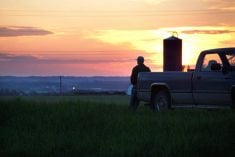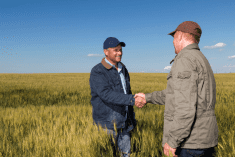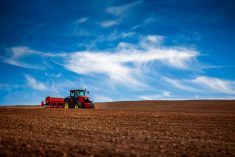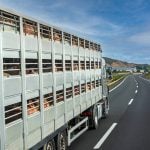The Economists….
Greg Mason is managing director of Prairie Research Associates (PRA) and economics professor at the University of Manitoba. PRA is a leading consultant on ag policy and research for Ottawa and for provincial governments across the country.
David Sparling is the first-ever ag business specialist at the Richard Ivey School of Business in London, Ont. Sparling left his position as associate dean of economics at the University of Guelph in order to take the Ivey position, a move that was helped with a $2 million grant from the federal government through the Agricultural Adaptation Council to set up an office of Agri-Food Innovation and Regulation at Ivey.
Read Also

Riding the tariff roller-coaster
What producers are doing to minimize the risk created by ongoing trade uncertainty.
David Kohl is emeritus professor of ag finance at Virginia Tech. Kohl says he has travelled over seven million miles in his career to study agriculture and to deliver over 5,000 workshops. Kohl is also president of AgriVisions LLC, a consulting firm, he is a business coach, and he is a partner in a dairy farm.
How Big Do I Need To Get?
The answer depends on what kind of farm you want to run. If it’s a commodity farm, the answer is just one word: “large,” perhaps even “million-dollar large.”
A decade ago, Sparling called a farm large if it had $250,000 in total annual farm revenue. Today, it takes twice as much gross revenue to qualify.
If the numbers double again in the next decade, it will take $1 million in gross income to be a large farm.
Is a large farm an average farm? There are two ways of looking at it. Only 11 per cent of all Canadian farms had annual revenues of at least $500,000 in 2005, Sparling points out. Yet they accounted for more than half of Canada’s total farm revenues, meaning the average for farm output is somewhere around the starting point for large farms.
More important, if you plan on farming in 2019, do you need to be a large farmer? If you’re a commodity producer, our economists say, the answer may well be yes, because large farms are driving the evolution of the commodity business.
“Farms will continue to get bigger and more capital intensive,” Sparling says.
The economic benefits of size are undeniable. Farmers may wish it wasn’t true, but their behaviour shows they agree. Already, the cut-off for economic viability seems to be around $250,000, Sparling says. Below that, according to federal statistics, the majority of farm family income comes from off-farm sources.
Now, economies of scale may accelerate, especially as costly new technologies come onto the market. (See Ready, set, Jump-Shift, page 30.)
For today’s farmer, says Kohl, it’s a call to adopt an aggressive business plan with concrete growth targets. At a minimum, he recommends farmers plan on a four to eight per cent annual increase in net farm income.
We’ve asked three of North America’s leading ag economists to look into their crystal balls. Not surprisingly, David Sparling, David Kohl and Greg Mason predict that some farms are going to call it quits
in the next decade. Others are going to have the ride of a lifetime. And many more are going to be somewhere in between.
What is surprising is their conviction that where you end up in 2019 will have little if anything to do with where you’re starting today.
Success is how you evolve from this day forward, they agree. Indeed, there may never have been a time when farming is more open to a whole world of business possibilities.
“The future is very bright,” says Mason. “The stars are coming into alignment.” Farmers will be retiring and land will be coming onto the market, he says, so there will be production opportunity at the same moment that food demand around the world will be booming.
Interested in being part of it? If you are, here are six questions you need to know how to answer.
Can I Survive If I Don’t Get Big?
Yes. In fact, the time is ripe to develop a sustainable business plan for a small-to medium-sized farm, these economists say. The catch is, you’ll need to get off the commodity treadmill.
Kohl foresees three distinct categories of farms. On the one end, large corporate farms will be mostly owned and operated by families. On the other, successful small operations will prosper by using savvy marketing to get premiums from value-added, niche or local sales.
In between, mid-sized family-owned farms will survive, providing they make it through the decade’s succession purge. But this will be an uneven category, with both winners and losers.
Fortunately, with a combination of determination and shrewd business management, it will be possible to make them profitable. “The mid-sized farm will exist in 2020, although there will be fewer,” says Kohl. “Their focus will be a ‘better is better’ instead of ‘bigger is better’ strategy.”
By better, Kohl means that these farms will be highly efficient, they’ll produce quality products and they’ll balance business with their lifestyle. (See related stories starting page 19.)
Meanwhile, there will be myriad opportunities for small farms. The sea change in farm attitudes is already underway, our economists say. Even within traditional ag circles, small farms are attracting a whole new level of respect.
In part, that’s because “small farm” doesn’t have to mean small revenues. In fact, many small-acreage farms generate more income than their much larger commodity-based counterparts.
Kohl is an example. He is one of four partners in Homestead Creamery, a Virginia farm business that produces premium milk in recycled glass bottles plus high-energy ice cream and other differentiated dairy products. On average, Homestead Creamery delivers $20 of dairy and local products weekly to each of 1,400 households.
“People want to experience the farm — the smells, the feel, the touch — of their food,” Kohl says.
Nor do small farms have to be on Calgary’s or Toronto’s doorstep. Opportunities for value-added, niche and specialty products exist wherever there’s a farm.
If you do farm small, however, it’s essential to see it as a business. Be entrepreneurial, and make a point of studying and learning from successful small farms, Kohl recommends. “If you want that business model, go to Europe because they’re about 10 years ahead of us.”
WHERE WILL WE FIND YOUNG FARMERS?
They will find you. In fact, it may be the ideal time to be in your 30s or early 40s and be hungry to farm.
An estimated 20 per cent of farms don’t have a next generation that wants to take over. For many others, succession is a looming decision that threatens to turn into a crisis because it isn’t being managed.
Even on farms that are talking succession, it’s a different discussion than ever before, for two reasons. That’s because Mom and Dad can expect to live longer, and they want to plan for a long, independent retirement.
It’s also different because children are deciding whether to stay or go based on whether they’ve got a passion for farm business. They aren’t following anyone’s footsteps.
That’s as it should be, Mason says. The good news is that because of long-term market fundamentals, those who have farming in their bones will be able to project a healthy, profitable future. It won’t always be a bed of roses but, says Mason, “There will be positive returns. There is a lot of good news on the horizon.”
Mason predicts that today’s parents should also be alert for a wave of non-farmers who are looking for ways to get their start.
“It’s a different age. It doesn’t matter what job you look at, children don’t do what their parents did,” Mason says. “We’re going to see a lot of interest in farming as a career choice by people who aren’t born on the farm.”
The challenge is for the existing farmer and the new farmer to work out how to transfer assets. “It really is a bridge financing issue,” says Mason. In fact, he believes governments may get involved too, much as they are already involved in guaranteeing student loans and even personal mortgages through the Canadian Mortgage and Housing Corporation.
Meanwhile, whether they’re homebred or whether they come from off the farm, this new generation of young farmers will find that enough retiring farmers are putting enough land and facilities onto the market to give them options to build successful farm businesses.
Many, however, may decide they never actually need to own those assets. Sparling points to what he calls “a mentality for non-ownership” in in the U.S. More farmers there are building business models based on food production, Sparling says, leaving it to investment companies to buy and lease the land.














